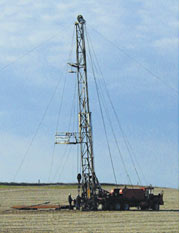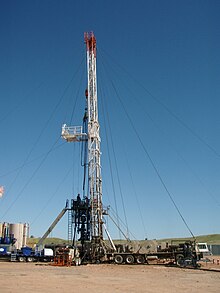Workover
This article needs additional citations for verification. (August 2010) |

The term workover is used to refer to any kind of
Reason to perform a workover
Workovers rank among the most complex, difficult and expensive types of well work. They are performed only if the well completion is terminally unsuitable for the job at hand. The

In other circumstances, the reason for a workover may not be that the completion itself is in a bad condition, but that changing
Operation
Before any workover, the well must first be killed. Since workovers are long planned in advance, there would be much time to plan the well kill and so the reverse circulation would be common. The intense nature of this operation often requires no less than the capabilities of a drilling rig.
The workover begins by killing the well then removing the wellhead and possibly the flow line, then installing a B.O.P. commonly known as a blowout preventer, then lifting the tubing hanger from the casing head, thus beginning to pull the completion out of the well. The string will almost always be fixed in place by at least one production packer. If the packer is retrievable it can be released easily enough and pulled out with the completion string. If it is permanent, then it is common to cut the tubing just above it and pull out the upper portion of the string. If necessary, the packer and the tubing left in the well can be milled out, though more commonly, the new completion will make use of it by setting a new packer just above it and running new tubing down to the top of the old one.
Workovers on casing
Although less exposed to wellbore fluids,
References
- .
- ^ Center, P.I.O.G.T. (2020). The employment on Offshore Drilling Platforms COMPLETE eBOOK. Petrogav International. p. 371.
